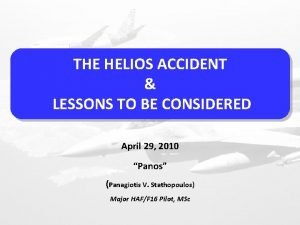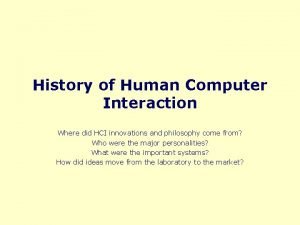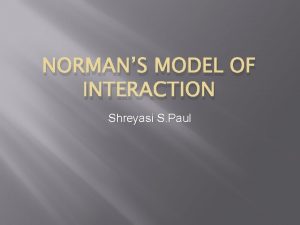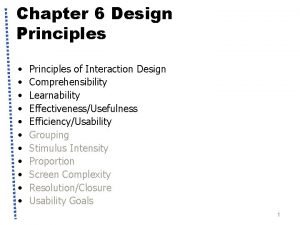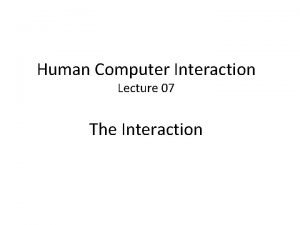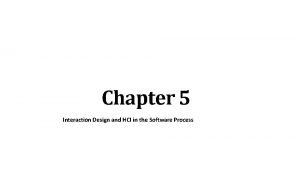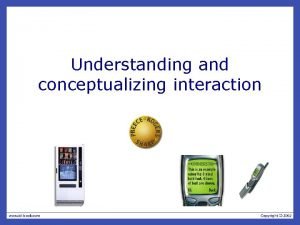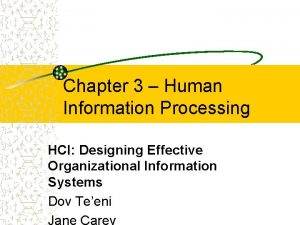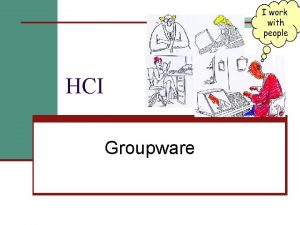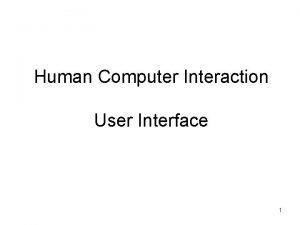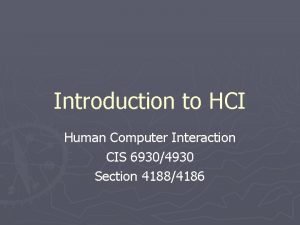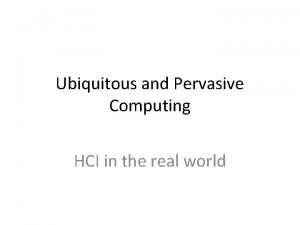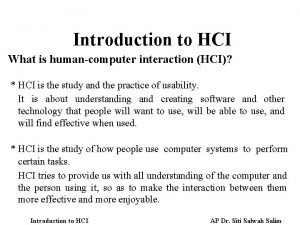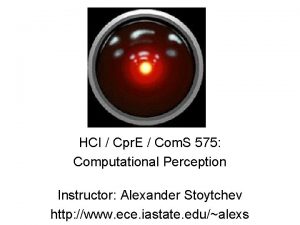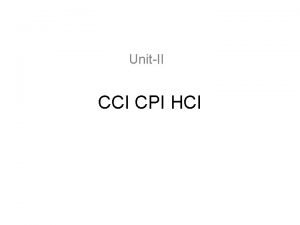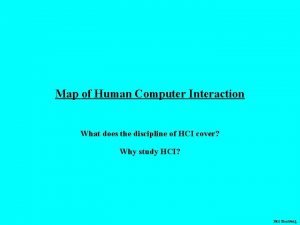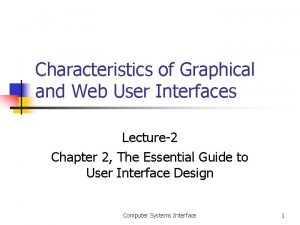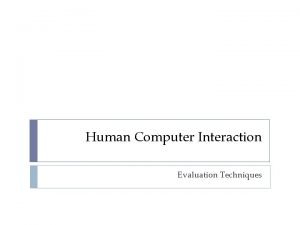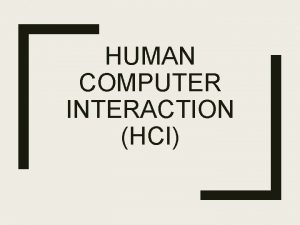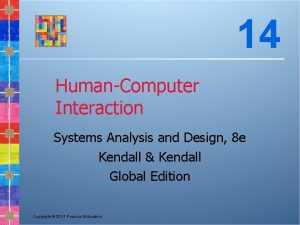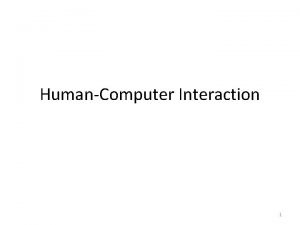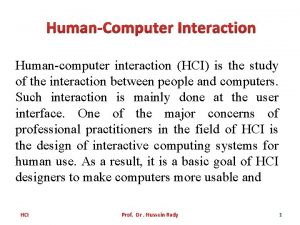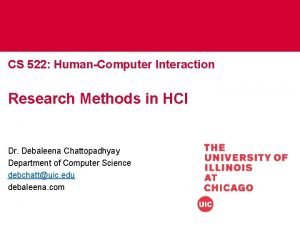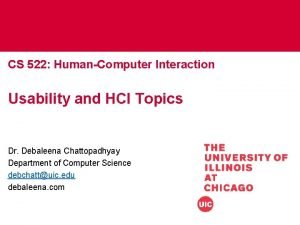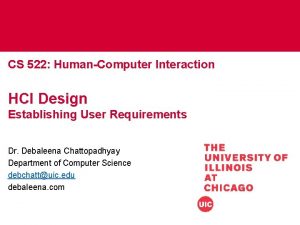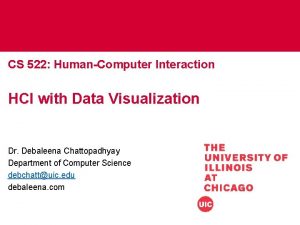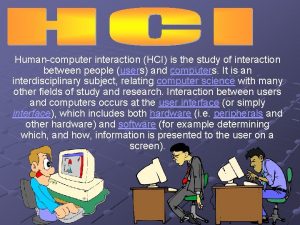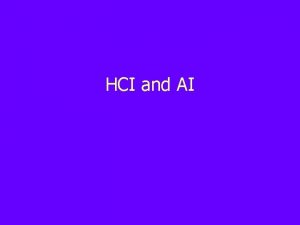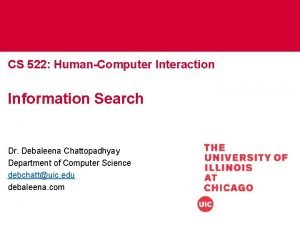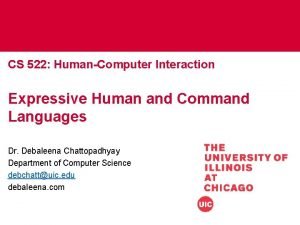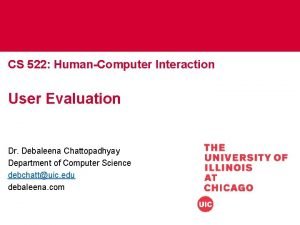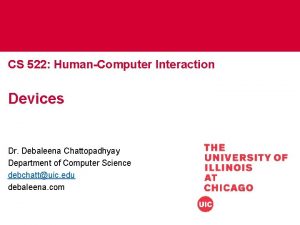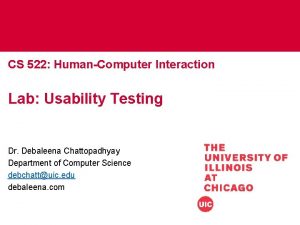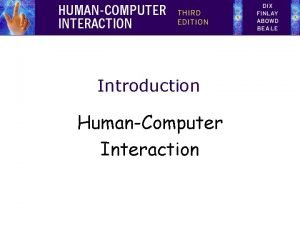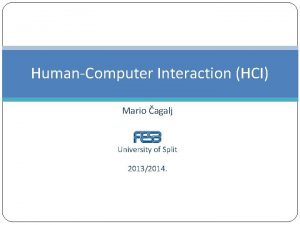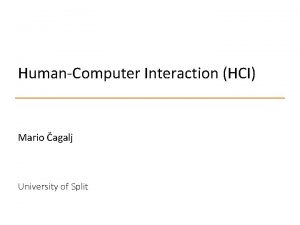CS 522 HumanComputer Interaction Psychology of HCI HumanInformation













































- Slides: 45

CS 522: Human-Computer Interaction Psychology of HCI Human-Information Processing, Error, Reliability. Dr. Debaleena Chattopadhyay Department of Computer Science debchatt@uic. edu debaleena. com

Human Information-processing (HIP) • A human being is a communication system receiving information from the environment, mentally acting on it, and responding to the environment. • The HIP approach is used to develop models of information flows in a human being. • HIP offers a framework for understanding and organizing a wide range of human-performance results.

Vase–Face Illusion Octavio Ocampo’s Don Quixote

Stimulus Perception Cognition Response Action The three stages of human information processing Input Sense Model Plan Act The four stage model sometimes used in artificial intelligence Output

Three Stage Model • Perception – Processes associated with perception and stimulus identification. • Cognition – Processes involved with decision making and thought. • Action – Processing cognitive information to select, prepare, and control actions to effect a response.

Visual LTM Limited capacity acoustic form system Response specification Limited capacity visual form system Limited capacity translator Visual symbols array Auditory LTM Response What are limitations in the model? (e. g. , Data-Limited Processing)

HIP and the Three Stage Model • Data-limited processing (DLP) – Degraded input information – A briefly flashed visual stimulus • Resource-limited processing (RLP) – The system lacks the power to perform the required operations • Structurally limited processing (SLP) – Failure to perform simultaneous actions (Action stage)

Detectability (or sensitivity) d’ is the distance between the peaks of the noise and signal distributions. Detectability is the observer’s ability to discriminate between signal or noise. It encompasses both false-alarm and hit rates.

Information Theory • Played a role in rise of Human Information Processing • Developed by communication engineers characterizing the flow of information in communication channels

Psychophysical & Information theory approach Vs. Chronometric approach • Psychophysical & Information theory approach – User’s response frequency is the dependent variable, upon which performance is evaluated. • Chronometric approach – The response condition is the independent variable, and we look at changes in reaction times.

Uncovering Psychological Structure with Chronometric Methods • Subtractive logic • Additive-factors logic • Continuous information accumulation

Subtractive Logic • It is a way of estimating the time required for particular mental operations in many different kinds of tasks. • Major assumptions: – Judgments are assumed to involve the same processes except for different stimuli. – We already assume what mental processes are responsible for a phenomenon, and then estimate their times.

Subtractive Logic Perception Cognition Action a seconds b seconds c = a - b seconds

Summary Human informationprocessing looks at the human as a system, which allows performance analysis looking at subsystems and component performance


Reliability and Human Error in Systems • What percentage of airline, drilling, and nuclear power plant accidents are attributed to human error? • At least 50%

The Central Concept in Human Factors: The System • What is a system in human factors? • The people, technologies, processes, and other parts work “together to achieve a common goal. ”

Implications of the System Concept • The operator is part of a human-machine system. – The performance of the whole system is evaluated. • The system is evaluated with respect to its goals. • The system can be decomposed into parts with their own subgoals.

Inputs and Outputs • A system and its components have inputs and outputs. – Distributed Cognition: Brains are control systems that help people orient to real-time signals that are observable in the world, but much of the “processing” occurs between people, not within people.

Physical System Variables • System variables can relate to function or performance. • Feedback indicates the difference between actual and desired outcomes. • What is negative feedback used for? – To reduce the difference between the actual and desired outcome.

• What is the difference between open-loop and closed-loop systems? • Which is pong? Which is baseball?

Operator Variables • What variables influence operator performance? – – – – Temperature, Humidity, Illumination Noise level Aptitude Training Motivation Stress Fatigue

Human error • What is an actor’s erroneous action? – An actor takes an unintended action. – The actor takes an action that an outside observer deems to be incorrect. – The actor takes an action that breaks a rule. – The actor takes an action that takes the system out of its acceptable limits.

Error Taxonomies • What are the taxonomies for error classification? – – Action classification Failure classification Processing classification Intentional classification

Error Taxonomies • What are the taxonomies for error classification? – Action classification • Errors of omission, commission, timing, sequence, selection, and quantitative errors.

Error Taxonomies • What are the taxonomies for error classification? – Failure classification • Recoverable, irrecoverable, operator, assembly, installation/maintenance errors. • Example? Make connectors of different sizes to avoid miswiring the fire warning panel on Boeing 737 s.

Error Taxonomies • What are the taxonomies for error classification? – Processing classification • Input/perceptual, output/motor, mediation/cognitive, and communication errors

Error Taxonomies • What are the taxonomies for error classification? – Intentional classification • Mistake (error in planning), slip (error in execution) • Which is harder to detect?

Reliability Analyses • What methods of analysis are available for human reliability? – Monte Carlo methods – Computational methods • How do they differ?

• Monte Carlo methods simulate performance using a system model. • Computational methods “analyze errors and their probabilities. ”

• If Monte Carlo methods simulate performance using a system model, how do we do this? (in brief) – – Run a trial simulation of the task-performing system. Repeat. Count the number of successful trials and divide by the total number of trials to calculate the probability of success.

Monte Carlo Method 1. 2. 3. 4. 5. 6. 7. Determine relevant parameters Describe system Compile input data Simulate system operations (including personnel) Output run data Repeat model runs Predict the system’s probability of success

• If computational methods “analyze errors and their probabilities, ” how do we do this?

Computational Method 1. 2. 3. 4. 5. 6. 7. Determine relevant parameters Describe system Identify potential errors Estimate error probabilities Identify error consequences Combine error probabilities Predict the system’s probability of success


GOMS "a set of Goals, a set of Operators, a set of Methods for achieving the goals, and a set of Selections rules for choosing among competing methods for goals. "

"a set of Goals, a set of Operators, a set of Methods for achieving the goals, and a set of Selections rules for choosing among competing methods for goals. " Keystroke-level model: K to press a key or button, P to point with a mouse to a target on a display, H to home hands on the keyboard or other device, D to draw a line segment on a grid, M to mentally prepare to do an action or a closely-related series of primitive actions, and R to represent the system response time during which the user has to wait for the system.

Monte-Carlo Simulation of Gesture Keyboards

Parameter Estimation This paper studies methodology for inference of parameter values of cognitive models from observational data in HCI. At the bottom of the figure, we have behavioral data (orange histograms), such as times and targets of menu selections. At the top of the figure, a cognitive model generates simulated interaction data (blue histograms). In this paper, approximate Bayesian computation (ABC) is investigated to identify the model parameter values that yield the best fit between the real data and simulator-generated data, while keeping the parameter values reasonable given prior knowledge. Inferring Cognitive Models from Data using Approximate Bayesian Computation. CHI’ 17. Antti Kangasrääsiö, Kumaripaba, Athukorala, Andrew Howes, Jukka Corander, Samuel Kaski, Antti Oulasvirta

Reliability Analysis: System Reliability What is reliability? • The probability that a system or subsystem will operate adequately in its intended application for a specified period of time.

System Reliability • What does this reliability measure tell us about how the components are arranged in the system? In other words, how are the components arranged? • In parallel

System Reliability (cont. . . ) • What does this reliability measure tell us about how the components are arranged in the system? In other words, how are the components arranged? • In series • Is it advisable to link low -reliability components in series?

Human Reliability • Pr(operator error) = # of errors made / # of opportunities to err Human reliability = 1 – Pr(operator error)

Application: Think. How would you design a UI for flight reservations that will decrease the system components connected serially, increase parallel components, provide closed-loop feedback to users about both user input and airline availability?

To do: • • CITI IRB – DUE Sep 5, 11: 59 pm CST (today) HW 1 out – today HW 1 DUE – Sep 14 Readings: Shneiderman et al. , 2017. Designing the User Interface. Chapter 5 (Evaluation and the User Experience), pp. 140— 179. • Sign up for your proposal presentations – DUE week 4, Sep 19
 Msfc-spec-522
Msfc-spec-522 Andreas prodromou helios 522
Andreas prodromou helios 522 Cube of 522
Cube of 522 Numberblock 3000
Numberblock 3000 It-522
It-522 Po box 63000 newark nj 07101
Po box 63000 newark nj 07101 History of human computer interaction
History of human computer interaction Modelling rich interaction
Modelling rich interaction Norman's seven stages of action
Norman's seven stages of action Interaction framework in hci
Interaction framework in hci Models of interaction in hci
Models of interaction in hci Elements of the wimp interface
Elements of the wimp interface Hci in software process
Hci in software process Paradigm of interaction in hci
Paradigm of interaction in hci Emotional interaction
Emotional interaction Interaction styles in hci
Interaction styles in hci Conceptual model in hci
Conceptual model in hci Positive psychology ap psychology definition
Positive psychology ap psychology definition Social psychology is the scientific study of
Social psychology is the scientific study of Group polarization example
Group polarization example Health psychology definition ap psychology
Health psychology definition ap psychology Social psychology ap psychology
Social psychology ap psychology Applied psychology vs psychology
Applied psychology vs psychology Mit csail hci
Mit csail hci Hci patterns may or may not include code for implementation
Hci patterns may or may not include code for implementation Human information processing hci
Human information processing hci Seeheim model hci
Seeheim model hci Task analysis in hci
Task analysis in hci What is groupware in hci
What is groupware in hci Hci user interface
Hci user interface Hclnomenclatura
Hclnomenclatura Common device with substantial hci design
Common device with substantial hci design Ubiquitous computing in hci
Ubiquitous computing in hci Introduction of hci
Introduction of hci Balancing function and fashion in hci
Balancing function and fashion in hci Perception hci
Perception hci Cci in ubiquitous computing
Cci in ubiquitous computing Poorfn
Poorfn Hci map
Hci map Graphical user interface advantages and disadvantages
Graphical user interface advantages and disadvantages Blazno resno o šoli kratka obnova
Blazno resno o šoli kratka obnova Esignature hci
Esignature hci Evaluation through user participation in hci
Evaluation through user participation in hci Ethnographic interview questions
Ethnographic interview questions Hci kendall
Hci kendall Definition of hci
Definition of hci

